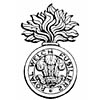The Royal Welch Fusiliers were a regiment of the British Army, part of the Prince of Wales' Division. It was founded in 1689 to oppose James II and the imminent war with France. The regiment was numbered as the 23rd Regiment of Foot, though it was one of the first regiments to be granted the honour of a fusilier title and so was known as The Welch Regiment of Fusiliers from 1702. The "Royal" accolade was earned fighting in the War of the Spanish Succession in 1713.
It is one of the oldest regiments in the regular army, hence the archaic spelling of the word Welch instead of Welsh. In the Boer War and throughout World War I, the army officially called the regiment "The Royal Welsh Fusiliers" but the archaic "Welch" was officially restored to the Regiment's title in 1920 under Army Order No.56. During those decades, the regiment itself unofficially used the "Welch" form. As of 2004, it was one of five line infantry regiments never to have been amalgamated in its entire history, the others being: - The Royal Scots
- The Green Howards
- The 22nd (Cheshire) Regiment
- The King's Own Scottish Borderers
The Regiment was amalgamated with the Royal Regiment of Wales (RRW) on 1 March 2006 to become 1st Battalion, The Royal Welsh (RRW becoming the 2nd Bn).
Soldiers of this regiment were distinguishable by the unique feature of the "flash", consisting of five overlapping black silk ribbons (seven inches long for soldiers and nine inches long for officers) on the back of the uniform jacket at neck level. This is a legacy of the days when it was normal for soldiers to wear pigtails. In 1808, this practice was discontinued, but the RWF were serving in America when the order to discontinue the use of the flash was issued. Upon their return they decided to retain the ribbons with which the pigtail was tied, and were granted this special concession by the King. The Army Board attempted to remove the flash during the First World War citing the grounds that it would help the Germans identify which unit was facing them. The King refused, stating that "The enemy will never see the backs of the Royal Welch Fusiliers". As a fusilier regiment, the RWF wore a hackle, which consists of a plume of white feathers worn on headdress and mounted behind the cap-badge.
History
The light infantry and grenadier companies of the Fusiliers saw bloody action at the Battle of Bunker Hill and the Battle of Guilford Court House in the American Revolutionary War. The Regiment participated in nearly every campaign from the Lexington & Concord to Yorktown. Many first hand accounts of the American Revolutionary War can be found in "the Diary of Lieutenant Frederick Mackenzie" or Serjeant Roger Lamb's "Original and Authentic Journal of Occurrences During the Late American War". The regiment also participated in the Napoleonic Wars - for example, at Waterloo, in the 4th Brigade under Lt-Col. Harry Mitchell, in the 4th British Infantry Division (see Order of Battle of the Waterloo Campaign.)
Several battalions of the regiment saw notable service in France and Belgium during World War I, in particular the 1st, which became forever associated with the terribly destructive action at Mametz Wood in 1916, and the 2nd, which endured the horrors of the massacre in the mud of Passchendaele (Third Ypres)in 1917. During this war, several writers served with various battalions of the regiment in France, including the poets Siegfried Sassoon, Robert Graves, David Jones and Hedd Wyn. Their memoirs have resulted in the activities of this regiment being vividly recorded for posterity. Ford Madox Ford wrote movingly of the Welsh soldiers he commanded in his four-volume novel Parade's End. Captain James C. Dunn, a medical officer attached to the regiment's 2nd Battalion during World War I, compiled a chronicle of that unit's experiences during its more than four years of service in France and Belgium. His epic, The War The Infantry Knew, has become a classic among military historians for its comprehensive treatment of all aspects of daily life and death in the trenches.
The regimental museum is located in Caernarfon, Wales, and the official headquarters are at Wrexham.
As with the Royal Regiment of Wales, the regiment has traditionally had a goat mascot. The tradition dates from at least 1775, and possibly from the regiment's formation. The goat is given full honours of an officer by all ranks and attended to by the Goat Major.
In 2004, it was announced that, as part of the restructuring of the infantry, the Royal Welch Fusiliers would amalgamate with the Royal Regiment of Wales to form a new large regiment, the Royal Welsh. This merger took place on 1 March 2006, leaving only two Welsh foot regiments in the British Army: the Welsh Guards and the Royal Welsh. The Royal Welch Fusiliers is now the name of the first battalion of the new regiment. 1st The Queen's Dragoon Guards is known as the Welsh cavalry, recruiting in Wales and the Welsh Marches.
The regiment's traditions are preserved in the United States by the Royal Welch Fusiliers in America, a living history organization that depicts the 23rd Foot as it appeared on April 19, 1775 -- the first day of the American War of Independence. | 


